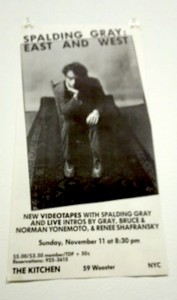Don Celender and The Kitchen
Portraiture study
If you could have your portrait painted by a famous artist of the past, or present, whom would you select? Why?
Don Celender
Picasso.
Because my eyes are on one side of my nose.
Herb Caen
Don Celender surveyed part 2 comprises series of mail-out art, where Don Celender mailed out questionnaires to various communities (general and professional) asking them to respond to a series of questions about life, work, art and death. This survey presents Portraiture study; Art dealers’ selection of artists survey, Artists survey, Ignored and neglected artist survey part 2, Aesthetic experiences survey, Art movements, Critics’ choice, Organisational art movement, Corporate art movement, and Mass media art movement. Consisting of a trail of white A4-size pages nailed onto white walls, the exhibition has a monastic sparseness. The gallery’s monochromatic walls offer numerous threads of the individual responses and non-responses to Celender’s questions and their context in time and the art profession. Unrestrained by linguistic gymnastics, the ideas come through the text directly.
In 2011, for its 40th anniversary, The Kitchen presented an exhibition, The view from a volcano: The Kitchen’s Soho years, 1971–85, showing the programming history of The Kitchen over more than ten years. The show consisted of single-channel videos and other artworks presented alongside audio and print documentation such as press releases, photographs of performances and posters from the shows. Artists included Vito Acconci, Nam June Paik, Robert Ashley and Carolee Schneeman, along with the Beastie Boys (as a group of four, including drummer Kate Schellenbach) and many more. Memorable threads were early Tony Oursler—a video of Oursler interviewing a woman about alien abductions; Bill Viola figuring out what a camera does; and discovering the neurotic Spalding Gray. Once again, the qualities of the work and their context emerged succinctly, through language that was accessible. The press releases revealed the artists’ desire to lay out an idea they appeared to be grappling with and, like Don Celender’s surveys, The view from a volcano as an exhibition managed to retain its content through time (past and present) as an archive and as individual works of art.
Often with a survey or an archive, language can become a turbulent terrain where the desire to express is lost to stylisation, perhaps as a result of self-consciousness, or a perception that this type of work needs to be propped up. The Don Celender and The Kitchen exhibitions are reminders of the value, pleasure and poetics that can be gained by having work just stand—through language.
Don Celender surveyed part 2, Crate Studio and Project Space, Margate, UK, curated by Sacha Waldron, 21 June – 11 August 2013.
The view from a volcano: The Kitchen’s Soho years, 1971–85, The Kitchen, New York, curated by Debra Singer, Matthew Lyons, and Lumi Tan, 30 June – 27 August 2011.







